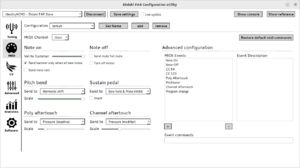The Ekdahl FAR - Configuration utility - Midi tab
The MIDI tab

While the Ekdahl FAR is certainly able to be controlled via MIDI, there is an issue with MIDIs default paradigm of being very centered around the concept of key-based instruments. Considering these limitations, and the obvious necessity for any modern electronic instrument to support MIDI, a extensive MIDI mapping "language" has been developed. Furthermore, because the Ekdahl FAR can be played in many different ways, several different 'MIDI Configurations' can be saved and recalled instantly, each configuration having its own MIDI mapping.
Internally, the Ekdahl FAR is entirely controlled by commands. These decide everything that the instrument is doing, whether it is playing a melody or changing an internal parameter. When a MIDI event occurs, the commands associated with it will be internally sent.
In order to make the user not have to learn the entire syntax of the MIDI mapping commands, the most common settings have been presented on the left halve of the MIDI tab. Please note however that changing any of these parameters will immediately overwrite any customization that has been made to the MIDI event in question.
Configuration
The drop-down box selects the current MIDI Configuration used, choosing a configuration from the list will instantly load it. The Set name-button opens a dialog that allows the user to rename the current configuration. The Add and Remove-buttons adds and removes configurations, a new configuration added will have the default parameters.
The MIDI Channel-drop-down selects which MIDI channel the Ekdahl FAR will respond to where "OMNI" means all channels.
The Restore default MIDI commands-button resets the current MIDI configuration to its default values and removes all added CCs.
Note On
This section decides what happens when a new Note On MIDI message - a key is being pressed down - is received.
The Vel to hammer-slider is a multiplier for how much of the MIDI Velocity is relayed to the hammer. A value of 0 effectively turns off the hammer.
When Send hammer only on new notes is checked the instrument uses legato-mode where the hammer only strikes on a new note if no other keys are previously held down.
Send mute rest makes the mute go into its rest-position on a new note, this is useful in order to make sure the string isn't muted when a new note is being emphasized. Forcing the mute into its rest-position however effectively overwrites any previous manual setting of the mute which could be detrimental if partial muting is being used.
Note Off
This section decides what happens when a new Note Off MIDI message - a key is being released - is received.
Send mute full mute will send the mute into its full muting position when a key is released.
Turn off motor will turn off the bowing motor when a key is released, this could be useful for making sure that the string isn't being resonated by the air turbulence created by the bowing wheel. Because of momentum and inertia however the motor will take some time to start up again from a complete stop, adding to a delay or glide when a new note is being played.
Pitch bend, Poly after touch and Channel after touch
These sections routes the corresponding MIDI messages to control a certain function, using the slider as multiplier.
Harmonic shift shifts the bowing wheels frequency up and down from the last note played by an amount given, the range available is set by the harmonic shift range under the Advanced-tab.
Pressure (modifier) and Pressure (baseline) both affects the pressure of the bowing wheel, the reason for having two distinct parameters doing the same thing is so that you can affect the pressure with different controls adding up to a total pressure rather than just over writing one controller with another.
Mute position set the position of the mute.
Solenoid force multiplier affects the incoming force of any hammer hit from any source and can be useful in for instance controlling a running sequence.
Sustain pedal
Unlike in the previous section, the sustain pedal MIDI message is either on or off and thus require its own explanation.
Bow hold means that the bow ignores any commands telling it to go to the rest position while the sustain pedal is depressed. This essentially mimics the behavior of infinite sustain.
Mute inhibit means that the mute ignores any commands telling it to go to the mute full mute position while the sustain pedals is depressed. This is equivalent to a regular sustain pedal on i.e. a piano.
Advanced
The MIDI events-list shows all MIDI events that have been mapped in the current MIDI configuration. Clicking on an event will make a description of the MIDI event appear to the right and contains information about any variables that specific event sends. The most basic MIDI events will always be in this list and cannot be removed (but their mapping can be), but the user can add and remove Continuous controllers to the MIDI mapping and associate them with custom commands. For more information please see the Command language-section.